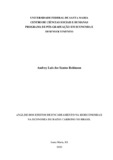| dc.creator | Robinson, Andrey Luis dos Santos | |
| dc.date.accessioned | 2021-08-10T11:43:55Z | |
| dc.date.available | 2021-08-10T11:43:55Z | |
| dc.date.issued | 2020-02-27 | |
| dc.identifier.uri | http://repositorio.ufsm.br/handle/1/21860 | |
| dc.description.abstract | The strategy of identifying and investing in those economic sectors capable of standing out of
the others dates back to the late 1950s, when Hirschman put forward the linkage hypothesis.
According to it, the difference between the most and least advanced sectors paves the way for
the deliberate undertaking of induced investments in a Keynesian-like multiplier effect.
Development should be set off by governmental investments in sectors with outstanding
performance (key sectors), the activity of which would propel that of the others. Forward
linkages (FL) single out the most spread (by-) products throughout the economy, whereas
backward linkages (BL) highlight the sectors that are the most dependent on the others. Such
effects are measured by indices calculated from the rows and columns of inverse input-output
matrices. It looks like the linkage hypothesis appears to fit in an energy transition scenario to
check how bioenergy consumption affects other sectors of the economy. By adding (IPA) to
the basic input-output (IP) model energy inputs and making use of the linkage hypothesis, it is
possible to spotlight the most dependent sectors and the most used inputs. Therefore, the
objective of this study is to build up a model that allows for not only identifying them, but
also for comparing the results disclosed by the standard (IP) and by the augmented (IPA)
input-output matrix. To this end, data for Brazil in 2018 are employed. Hence, when all of the
country’s energy inputs are indistinctively taken into account, the Transport sector is the most
dependent one, and Petroleum and Oil Products are the most demanded (spread) energy inputs
by the economy. The results change when the emphasis is placed upon bioenergy inputs. In
this case, the Paper and Pulp sector is the most dependent one, while Black Liquor turns out
to be the most widely consumed bioenergy input. It can be concluded that such changes drive
both the investments and the development strategy to be designed. For instance, reducing the
use of fossil fuels (Oil Products) would harm investments in the Transport sector, whereas the
option for a bioeconomic strategy of development would favour the Paper and Pulp sector. | eng |
| dc.description.sponsorship | Coordenação de Aperfeiçoamento de Pessoal de Nível Superior - CAPES | por |
| dc.language | por | por |
| dc.publisher | Universidade Federal de Santa Maria | por |
| dc.rights | Attribution-NonCommercial-NoDerivatives 4.0 International | * |
| dc.rights.uri | http://creativecommons.org/licenses/by-nc-nd/4.0/ | * |
| dc.subject | Bioeconomia | por |
| dc.subject | Bioenergia | por |
| dc.subject | Matriz insumo-produto ampliada | por |
| dc.subject | Encadeamentos | por |
| dc.subject | Bioeconomy | eng |
| dc.subject | Bioenergy | eng |
| dc.subject | Augmented input-output matrix | eng |
| dc.subject | Linkage effects | eng |
| dc.title | Análise dos efeitos de encadeamento na bioeconomia e na economia de baixo carbono no Brasil | por |
| dc.title.alternative | Analysis of the linkage effects in the Brazilian bio- and lowcarbon economy | eng |
| dc.type | Dissertação | por |
| dc.description.resumo | A estratégia de identificar e investir em setores econômicos capazes de se destacar dos
demais remete ao final da década de 1950, quando Hirschman sugeriu a hipótese dos
encadeamentos (linkages). Segundo ela, a diferença entre setores mais avançados e menos
avançados abre margem para ações deliberadas de investimentos induzidos, à maneira do
efeito multiplicador keynesiano. O desenvolvimento seria proporcionado por investimentos
estatais nas atividades com desempenho acima da média (setores-chave), que propulsionariam
as demais. Os encadeamentos para frente identificam os (sub)produtos mais disseminados
pela economia, enquanto os encadeamentos para trás ressaltam os setores mais dependentes
dos demais. Tais efeitos são medidos por índices calculados a partir das linhas e colunas das
matrizes inversas de insumo-produto. Ao que parece, a hipótese dos encadeamentos parece
ser adequada ao cenário de transição energética, para verificar como o consumo bioenergético
afeta os demais setores da economia. Ampliando-se (IPA) o modelo básico de insumoproduto
(IP) com insumos energéticos e utilizando-se a hipótese dos encadeamentos, é
possível destacar os setores mais dependentes e os insumos mais utilizados. Portanto, o
objetivo deste trabalho é elaborar um modelo que permita não só identificá-los, mas também
comparar os resultados obtidos pela matriz tradicional (IP) e pela matriz ampliada (IPA) de
insumo-produto. Com essa finalidade, utilizam-se dados para o Brasil em 2018. Assim,
quando indistintamente se consideram todos os recursos energéticos do país, o setor de
Transportes é o mais dependente, e os Derivados de Petróleo são os insumos energéticos mais
demandados (disseminados) pela economia. Os resultados mudam quando a ênfase recai
sobre os insumos bioenergéticos. Nesse caso, o setor de Papel e Celulose é o mais
dependente, e a Lixívia é o insumo bioenergético mais consumido. Conclui-se que tais
alterações afetam tanto o direcionamento dos investimentos quanto a estratégia de
desenvolvimento a ser utilizada. Por exemplo, a redução do uso de combustíveis fósseis
(Derivados de Petróleo) prejudicaria os investimentos no setor de Transportes, ao passo que a
adoção de uma estratégia bioeconômica de desenvolvimento favoreceria o setor de Papel e
Celulose. | por |
| dc.contributor.advisor1 | Giacomelli Sobrinho, Valny | |
| dc.contributor.advisor1Lattes | http://lattes.cnpq.br/1995969396329156 | por |
| dc.contributor.referee1 | Feistel, Paulo Ricardo | |
| dc.contributor.referee2 | Oliveira, Cassius Rocha de | |
| dc.creator.Lattes | http://lattes.cnpq.br/5482797919248702 | por |
| dc.publisher.country | Brasil | por |
| dc.publisher.department | Economia | por |
| dc.publisher.initials | UFSM | por |
| dc.publisher.program | Programa de Pós-Graduação em Economia e Desenvolvimento | por |
| dc.subject.cnpq | CNPQ::CIENCIAS SOCIAIS APLICADAS::ECONOMIA | por |
| dc.publisher.unidade | Centro de Ciências Sociais e Humanas | por |



